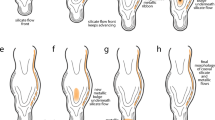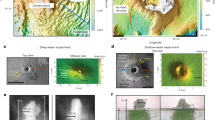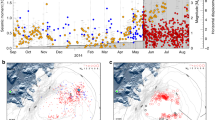Abstract
Caldera-forming eruptions can be explosive and lead to the eruption of phenomenal volumes of magma that can devastate the global environment1. Such eruptions involve ground subsidence related to catastrophic sinking of a magma chamber roof, accompanied by buoyant flow of magma through a ring conduit around the sinking roof 2. Previous work points to a feedback between subsidence and eruption: eruption initiates subsidence of the chamber roof, which in turn drives the ongoing eruption3. Although subsidence-driven eruption dominates caldera evolution4, the coupled dynamics of subsidence and magma flow are poorly understood. Here, we use analogue models to show that, under most conditions, caldera subsidence is spatially and temporally variable, leading to complicated and vigorous magma stirring and mixing. On the basis of the experimental results and a scaling analysis, we construct a regime diagram that helps demonstrate how the coupled flow and subsidence are influenced by the fluid dynamics and geometry of the system. The vigorous stirring we infer can considerably modify the style of subsidence and can explain textural, petrological and geochemical variation in deposits that have been related to caldera-forming eruptions.
This is a preview of subscription content, access via your institution
Access options
Subscribe to this journal
Receive 12 print issues and online access
$259.00 per year
only $21.58 per issue
Buy this article
- Purchase on Springer Link
- Instant access to full article PDF
Prices may be subject to local taxes which are calculated during checkout




Similar content being viewed by others
References
Rampino, M. & Self, S. Volcanic winter and accelerated glaciation following the Toba super-eruption. Nature 359, 50–52 (1992).
Fouqué, F. Santorin et ses Eruptions (Masson, Paris, 1879).
Druitt, T. & Sparks, R. S. J. On the formation of calderas during ignimbrite eruptions. Nature 310, 679–681 (1984).
Hildreth, W. & Wilson, C. Compositional zonation in the Bishop Tuff. J. Petrol. 48, 951–999 (2007).
Druitt, T. H. & Bacon, C. R. Petrology of the zoned calcalkaline magma chamber of Mount Mazama, Crater Lake, Oregon. Contrib. Mineral. Petrol. 101, 245–259 (1989).
Simkin, T. & Howard, K. A. Caldera collapse in the Galápagos Islands, 1968. Science 169, 429–437 (1970).
Kumagi, H. et al. Very-long-period seismic signals and caldera formation at Miyake Island, Japan. Science 293, 687–690 (2001).
Folch, A., Codina, R. & Marti, J. Numerical modeling of magma withdrawal during explosive caldera-forming eruptions. J. Geophys. Res. 106, 16163–16175 (2001).
Trial, A. F., Spera, F. J., Greer, J. & Yuen, D. A. Simulations of magma withdrawal from compositionally zoned bodies. J. Geophys. Res. 97, 6713–6733 (1992).
Acocella, V. Understanding caldera structure and development: An overview of analogue models compared to natural calderas. Earth Sci. Rev. 85, 125–160 (2007).
Allen, J. J. & Chong, M. S. Vortex formation in front of a piston moving through a cylinder. J. Fluid Mech. 416, 1–28 (2000).
Blake, S. & Ivey, G. N. Magma mixing and the dynamics of withdrawal from stratified reservoirs. J. Volcanol. Geotherm. Res. 27, 153–178 (1986).
Blake, S. & Campbell, I. H. The dynamics of magma-mixing during flow in volcanic conduits. Contrib. Mineral. Petrol. 94, 72–91 (1989).
Koyaguchi, T. Magma mixing in a conduit. J. Volcanol. Geotherm Res. 25, 365–369 (1985).
Ottino, J. The Kinematics of Mixing: Stretching, Chaos and Transport (Cambridge Univ. Press, Cambridge, 1989).
Muira, D. Effects of changing stress states on the development of caldera-bounding faults: Geological evidence from Kumano caldera, Japan. J. Volcanol. Geotherm. Res. 144, 89–103 (2005).
Tucker, D. et al. Geology and complex collapse mechanisms of the 3.72 M Hannegan caldera, North Cascades, Washington, USA. Geol. Soc. Am. Bull. 119, 329–343 (2007).
Yoshida, T. Tertiary Ishizuki, cauldron, southwestern Japan arc: Formation by ring fracture subsidence. J. Geophys. Res. 89, 8502–8510 (1984).
Kennedy, B. & Stix, J. Magmatic processes associated with caldera collapse at Ossipee ring dike, New Hampshire. Geol. Soc. Am. Bull. 119, 3–17 (2007).
Sparks, R. S. J. Petrology and geochemistry of the Loch Ba ring-dyke, Mull (N.W. Scotland): An example of the extreme differentiation of tholeiitic magmas. Contrib. Mineral. Petrol. 100, 446–461 (1988).
McDonnell, S. et al. Intrusive history of the Slieve Gullion ring dyke, Ireland: Implications for the internal structure of silicic sub-caldera magma chambers. Mineral. Mag. 68, 725–738 (2004).
White, F. M. Viscous Fluid Flow (McGraw-Hill, New York, 1991).
Heiken, G. et al. The Valles/Toledo caldera complex, Jemez Volcanic field, New Mexico. Annu. Rev. Earth Planet. Sci. 18, 27–53 (1990).
Druitt, T. H. Vent evolution and lag breccia formation during the Cape Riva eruption of Santorini, Greece. J. Geol. 93, 439–454 (1985).
Wolff, J. A., Woerner, G. & Blake, S. Gradients in physical parameters in zoned felsic magma bodies; Implications for evolution and eruptive withdrawal. J. Volcanol. Geotherm. Res. 43, 37–55 (1990).
Petford, N., Kerr, R. C. & Lister, J. R. Dike transport of granitoid magmas. Geology 21, 845–847 (1993).
Wilson, C. J. N. & Hildreth, W. H. The Bishop Tuff; new insights from eruptive stratigraphy. J. Geol. 105, 407–439 (1997).
Wallace, P. J., Anderson, A. T. & Davies, A. M. Gradients in H2O, CO2, and exsolved gas in a large-volume silicic magma system: Interpreting the record preserved in melt inclusions from the Bishop Tuff. J. Geophys. Res. 104, 20097–20122 (1999).
Bryan, S. Petrology and geochemistry of the quaternary caldera-forming, Phonolitic Granadilla Eruption, Tenerife (Canary Islands). J. Petrol. 47, 1557–1589 (2006).
Dreher, S. T., Eichelberger, J. C. & Larsen, J. F. The petrology and geochemistry of the aniakchak caldera-forming Ignimbrite, Aleutian Arc, Alaska. J. Petrol. 46, 1747–1768 (2005).
Acknowledgements
We thank R. Breger, T. Barton, A. Peterson, G. Robert and S. Wiingaard for their assistance with experiments. Support was provided to B.M.K. from the Department of Earth and Planetary Sciences, McGill University, from GEOTOP, Université du Québec à Montréal and from the Canadian Institute for Advanced Research. A.M.J. acknowledges support from the Natural Sciences and Engineering Research Council of Canada, the Canadian Institute for Advanced Research and the Marsden Fund. J.S. acknowledges support from the Natural Sciences and Research Council of Canada and from le Fonds Quebecoise de la Research sur la Nature et les Technologies.
Author information
Authors and Affiliations
Contributions
B.M.K., A.M.J. and J.S. all contributed to carrying out experiments and analysing data, as well as writing, planning and editing this manuscript.
Corresponding author
Rights and permissions
About this article
Cite this article
Kennedy, B., Mark Jellinek, A. & Stix, J. Coupled caldera subsidence and stirring inferred from analogue models. Nature Geosci 1, 385–389 (2008). https://doi.org/10.1038/ngeo206
Received:
Accepted:
Published:
Issue Date:
DOI: https://doi.org/10.1038/ngeo206
This article is cited by
-
Rifting and recharge as triggers of the mixed basalt–rhyolite Halarauður ignimbrite eruption (Krafla, Iceland)
Contributions to Mineralogy and Petrology (2022)
-
Magma chamber decompression during explosive caldera-forming eruption of Aira caldera
Communications Earth & Environment (2021)
-
Resurgence initiation and subsolidus eruption of cold carapace of warm magma at Toba Caldera, Sumatra
Communications Earth & Environment (2021)
-
Caldera-forming eruptions of mushy magma modulated by feedbacks between ascent rate, gas retention/loss and bubble/crystal framework interaction
Scientific Reports (2019)
-
Volcanic bipolar disorder explained
Nature Geoscience (2014)



